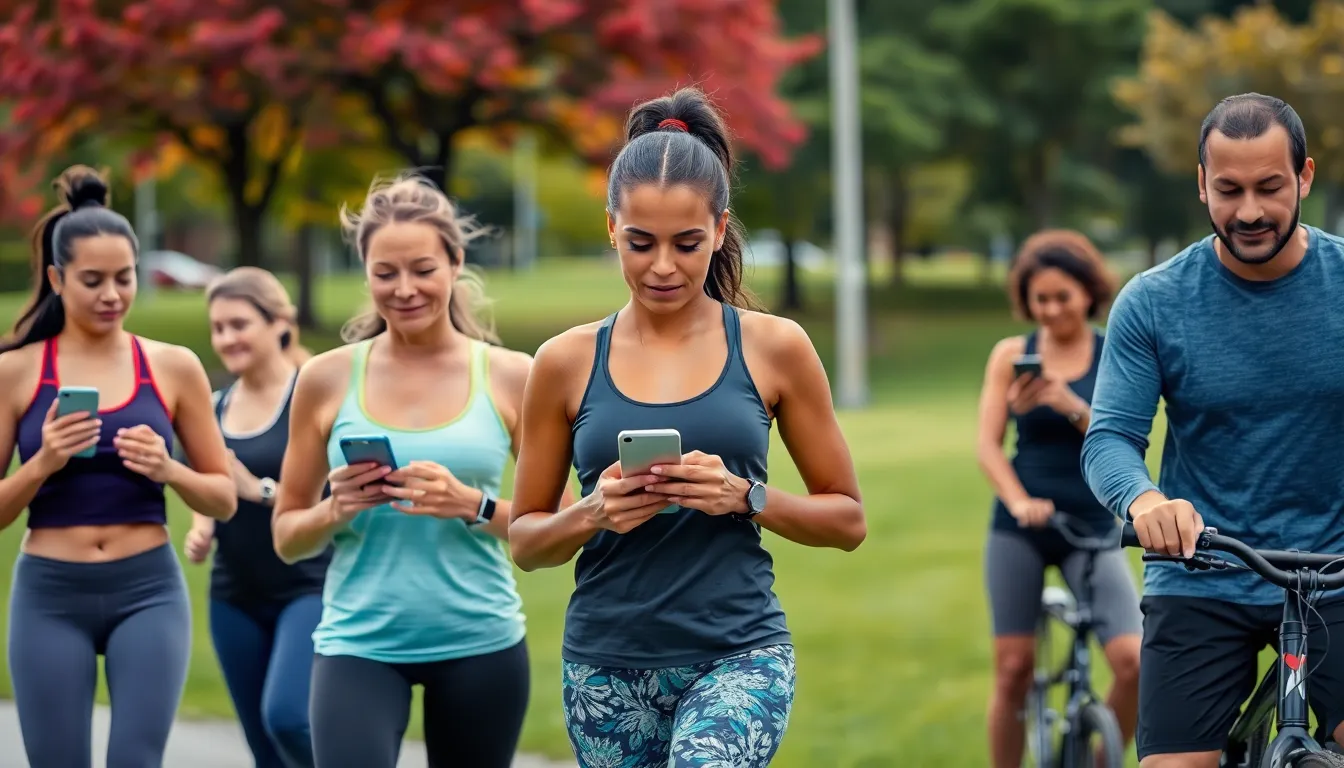In a world where binge-watching TV shows is a competitive sport, finding the motivation to exercise can feel like a Herculean task. Enter fitness apps—the superheroes of the digital age, ready to save the day (and your waistline). With a tap on the screen, users can transform their phones into personal trainers, nutritionists, and workout buddies, all while avoiding the awkward small talk at the gym.
Overview of Fitness Apps
Fitness apps play a crucial role in supporting users’ exercise journeys. They offer a wide range of features designed to enhance motivation and track progress. Many apps provide customizable workout plans tailored to individual goals and fitness levels.
Tracking tools help users monitor their activities, calories burned, and nutritional intake. With real-time feedback, these apps keep users engaged and accountable. Some platforms even incorporate social elements, allowing users to connect with friends for added motivation.
Popular apps such as MyFitnessPal, Strava, and Nike Training Club serve millions of users worldwide. Each app boasts unique features, catering to various preferences and fitness needs. Budget-conscious individuals may want to explore free options, while others might invest in premium versions for advanced capabilities.
Integration with wearable devices is another valuable feature. Syncing with smartwatches or fitness trackers provides comprehensive data on heart rate and exercise duration. Such integration enhances the overall experience, making it easier for users to stay informed and adjust their routines accordingly.
Community support is often a significant factor in a user’s success. Many apps foster online communities where users can share achievements, tips, and encouragement. This sense of belonging strengthens determination and commitment to fitness goals.
Fitness apps not only transform phones into personal trainers but also create an accessible fitness environment. They remove barriers associated with traditional gym settings, allowing users to exercise comfortably at home or outdoors. With consistent updates and new features, these apps continue to evolve, ensuring they meet the dynamic needs of fitness enthusiasts.
Types of Fitness Apps


Fitness apps come in various categories, each serving unique purposes to support users’ health and wellbeing.
Workout Tracking Apps
Workout tracking apps focus on recording physical activities. Users log exercises and monitor performance metrics. These apps often provide features like GPS tracking for outdoor activities and tailored workout plans. MyFitnessPal and Strava excel in offering comprehensive workout tracking tools. Users can access real-time analytics, helping to adjust routines and maintain motivation. With integrations for wearable devices, these apps enhance the tracking experience further. The ability to set goals and review progress keeps individuals accountable in their fitness journeys.
Nutrition Tracking Apps
Nutrition tracking apps assist individuals in managing their dietary habits. Users input food items and monitor calorie intake. Apps like MyFitnessPal track both nutrients and daily calories effectively. They often provide extensive databases of food items, making logging quick and easy. Users benefit from personalized meal plans to align with fitness goals. Many nutrition apps also allow users to scan barcodes for seamless tracking. With community features, users can share recipes and meal ideas, encouraging healthier eating habits.
Meditation and Mindfulness Apps
Meditation and mindfulness apps cater to mental fitness needs. Users explore guided meditations focused on stress relief and relaxation. Apps like Headspace and Calm provide daily sessions suitable for various experience levels. These platforms promote better mental clarity and emotional stability through mindfulness practices. Users can select durations and themes, ensuring a tailored experience for individual preferences. Engaging with these apps fosters a holistic approach to fitness, integrating mental wellness with physical health.
Top Fitness Apps Reviewed
Fitness apps serve as essential tools for achieving health goals. Each app offers unique features to enhance user experience and support fitness journeys.
App 1: Features and Benefits
MyFitnessPal excels at nutrition tracking. Users can log food intake quickly and access a database with millions of entries. Detailed analytics provide insights into calories and macronutrients consumed. Personalized meal plans help individuals stay on track with their dietary goals. Integration with other fitness devices allows seamless activity tracking. Moreover, community features enable users to connect and motivate each other, fostering a supportive atmosphere.
App 2: Features and Benefits
Strava stands out for its workout tracking capabilities. Cyclists and runners can utilize GPS tracking to monitor their routes and speeds. Real-time performance metrics keep users motivated during workouts. Social features build a community where users share achievements and challenges. Customizable training plans cater to varying fitness levels, offering tailored guidance. Regularly updated leaderboard challenges spark friendly competition among friends.
App 3: Features and Benefits
Nike Training Club delivers an extensive library of workouts. Users can choose from various fitness levels and durations, ensuring sessions fit into any schedule. Video demonstrations provide clear guidance for each exercise, promoting correct form. The app includes options for strength, endurance, and mobility training. Moreover, it offers personalized fitness plans designed to align with individual goals. Users can track their progress over time, celebrating milestones and accomplishments.
Factors to Consider When Choosing Fitness Apps
Choosing a fitness app requires careful evaluation of several key factors. User interface matters significantly; intuitive designs lead to better engagement. App compatibility is essential as well, especially concerning devices like smartphones and wearables. Features like workout tracking, meal planning, and community support can greatly enhance the experience.
Customization options play a pivotal role in meeting individual fitness goals. The ability to tailor workout plans or dietary preferences to specific needs promotes adherence. Real-time feedback features also keep users motivated, ensuring a responsive fitness environment.
Social connectivity should not be overlooked; interacting with peers adds accountability. Community interactions foster encouragement, making workouts more enjoyable. Cost is another important consideration; free apps may provide basic functions, while premium options often include advanced features and personalized content.
Regular updates enhance functionality by incorporating user feedback and new trends. Security of personal data cannot be ignored; apps must ensure user information remains private. Popular choices like MyFitnessPal, Strava, and Nike Training Club often excel in many of these areas, providing users with comprehensive solutions for fitness journey needs.
Finally, user reviews offer insights into the app’s real-world effectiveness. Reading experiences from others helps in assessing actual performance versus advertised benefits. Balancing these factors ensures a well-rounded app selection that aligns with personal fitness objectives.
Fitness apps are revolutionizing how individuals approach their health and wellness. By providing personalized guidance and fostering community support, these tools empower users to stay committed to their fitness goals. With a wide range of options available, from workout tracking to nutrition management, there’s an app for everyone.
As technology continues to evolve, so do these fitness solutions, ensuring they remain relevant and effective. Embracing these apps can lead to lasting lifestyle changes, making fitness more accessible and enjoyable than ever before. Whether at home or on the go, users can find motivation and support right at their fingertips.
